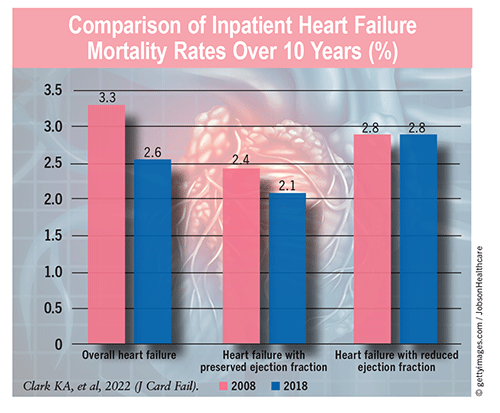US Pharm. 2024;49(2):14.
Heart failure (HF) is a progressive condition in which the heart is unable to fill with or eject sufficient blood. Almost one-half of HF patients have HF with preserved ejection fraction (HFpEF); the rest have HF with reduced EF (HFrEF). Lifestyle modifications and treatment with devices and/or pharmacologic agents can address related manifestations, slow the progression of HF, and maintain or maximize quality of life.

Prevalence: HF affects approximately 6.7 million U.S. adults, up from 6 million in 2017. According to National Health and Nutrition Examination Survey data, HF prevalence in U.S. adults has ranged from 1.9% to 2.6% over the past 2 decades and is projected to rise to 8.5 million in 2030. Adults aged >65 years have a fourfold greater HF prevalence (8.0%-9.1%) than those aged <65 years. HF prevalence is also higher in black Americans and in women. In one study, prevalence in black men, black women, white men, and white women over a 10-year period was 38.1/1,000 person-years, 30.5/1,000 person-years, 20.7/1,000 person-years, and 15.2/1,000 person-years, respectively. Significant increases of +4.3% and +1.9% per year in black women and white women, respectively, were also found.
Medication Use: Over the years, HF guidelines have recommended for or against various pharmacotherapies. One study examined medication use within 90 days of first HFpEF diagnosis in 156,730 patients (mean age 73 years; 57% female). From 2008 to 2020, increased utilization rates were reported for calcium channel blockers (30.6% vs. 33.4%), angiotensin receptor blockers (14.3% vs. 18.6%), and aldosterone receptor antagonists (7.0% vs. 8.4%) (all, P <.01). Rates also increased for sodium-glucose cotransporter 2 inhibitors (0.001% vs. 0.021%) from 2013 to 2020 and angiotensin receptor/neprilysin inhibitors (0.02% vs. 0.17%) from 2015 to 2020 (both, P <.01). From 2008 to 2020, utilization rates decreased for ACE inhibitors (30.4% vs. 20.5%, P <.01), digoxin (9.5% vs. 2.4%, P <.01), nitrates (10.7% vs. 4.9%, P <.01), diuretics (54.1% vs. 50.4%, P = .20), and beta-blockers (52.6% vs. 51.7%, P <.01). Rates for phosphodiesterase-5 inhibitors remained stable (1.5% vs. 1.1%, P = .90).
Morbidity and Mortality: HF is the main cause of hospitalization among Medicare patients. The National Inpatient Sample identified 1,270,360 HF hospitalizations in 2018; this was an increase from 1,060,540 hospitalizations in 2008. During this time frame, hospitalized patients’ median age decreased from 76 years to 73 years, and the proportion of black and Hispanic patients increased significantly. Compared with patients with HFrEF, patients hospitalized for HFpEF were older and more likely to be white. Incidences of comorbid diabetes, sleep apnea, and obesity also increased from 2008 to 2018. Inpatient mortality declined significantly for overall HF (3.3%-2.6%) and HFpEF (2.4%-2.1%) but remained stable for HFrEF (2.8%).
The content contained in this article is for informational purposes only. The content is not intended to be a substitute for professional advice. Reliance on any information provided in this article is solely at your own risk.
To comment on this article, contact rdavidson@uspharmacist.com.





